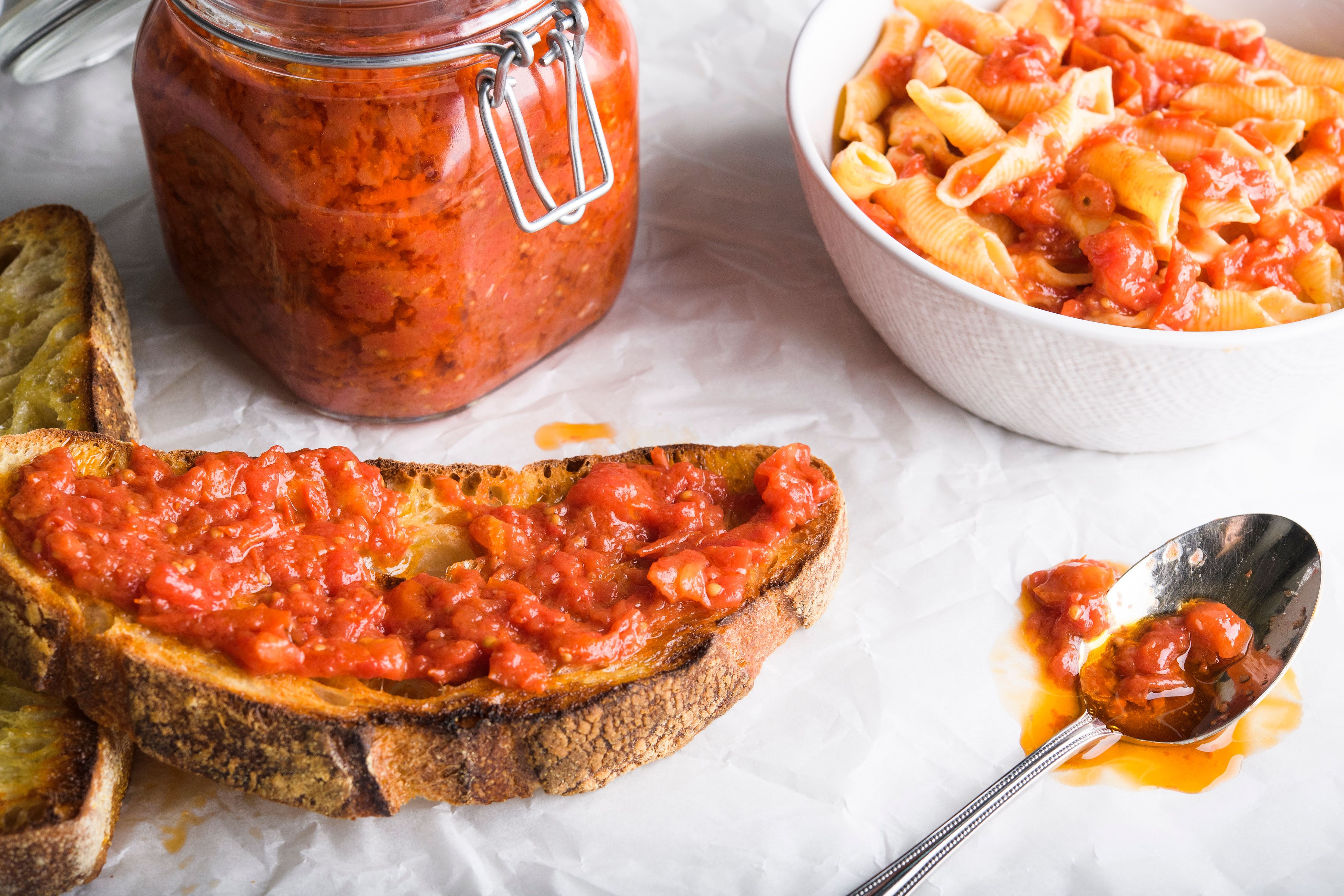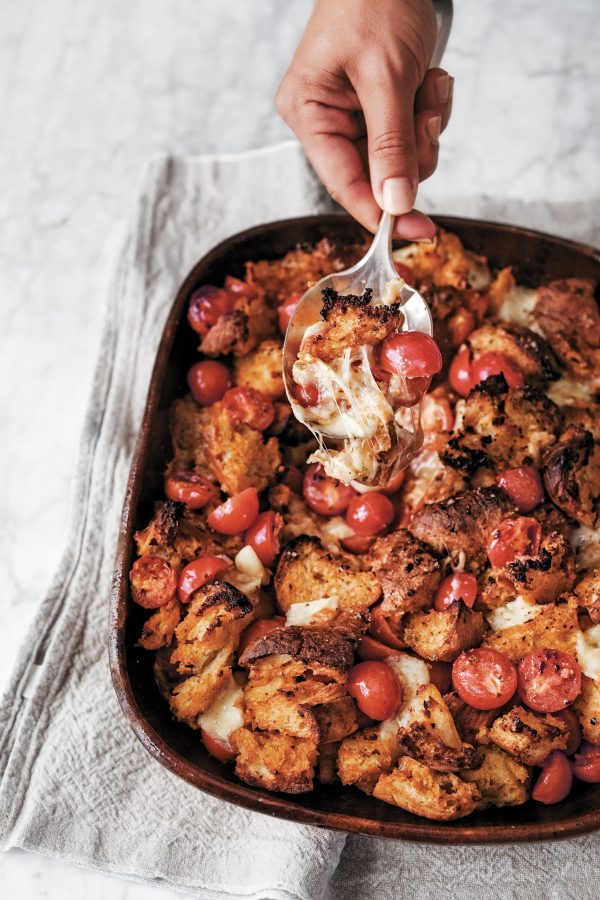We asked Rome-based cookbook author Katie Parla what go-to ingredients she keeps in her kitchen to throw together quick dishes with big flavor.
Parla, an Italian-American who’s lived in Rome for the last 16 years, comes out with her newest book, “Food of the Italian South: Recipes for Classic, Disappearing, Lost Dishes,” next week. In this latest stunner, featuring photos by Ed Anderson, Parla translates and preserves recipes from the south that run the risk of vanishing with older generations.
Traveling frequently to the south to explore her family heritage, Parla recounts finding villages with depleted populations and very few young people. “Where there were young people,” she adds, “they were so busy with work and managing the 21st century Italian life, they weren’t always cooking Italian recipes.”
“This isn’t a phenomenon unique to Southern Italy or Italy or even Europe,” Parla notes, “but Southern Italy in particular over the last two centuries has suffered economic collapse that has forced people to leave.” That’s why her family moved from a small town called Spinoso in Basilicata to the United States, and why she felt so compelled to keep tradition alive.
Back in her kitchen in Rome, Parla developed recipes based on her travels from Campania to Calabria, simplifying where she could to make dishes realistic for the modern home cook. As she says, “It’s only through cooking and eating that these recipes can be preserved.” Below is a list of nine powerhouse ingredients she regularly relies on for their flavor and versatility.
Salted Anchovies
Instead of the kind that come in oil, Parla prefers salt-packed anchovies for their subtlety and flavor. Rinse, remove the spine and tail fin, and soak in cold water for 15 minutes before use. Eat them with butter on toast, melt into sauces or grind into a pulp and mix with herbs for the base of a bold vinaigrette. Try hand-processed Nettuno Salted Anchovies from Cetara, Campania.
Colatura Anchovy Sauce
Parla’s go-to pasta when she’s “down to the bare necessities” is spaghetti tossed with olive oil, smashed garlic, parsley and colatura, a savory, potent condiment most famously from Cetara made with anchovies that have been layered with salt and left to ferment in barrels for years. “Yes, in Italy, colatura, a traditional fish sauce, is a standard pantry item,” she writes in the book. Or, try it drizzled over sautéed greens. Be sure to add off the heat to avoid a bitter flavor. Try Nettuno Colatura Anchovy Sauce from Cetara, Campania.
Whole Peeled Tomatoes
Parla likes well-known San Marzano but also frequently uses Piennolo for their thick skin and herbaceous, vegetal flavor. They’re best in sauces that are barely cooked: For a simple, speedy red sauce, sauté garlic and chili, add the tomatoes and cook for just a few minutes, she says.

‘Nduja: Spicy, Spreadable Salami
“Calabria is known for strong flavors,” Parla says, “and ‘nduja [which is originally from Calabria], falls into that category for sure.” Spread it on toast or melt it into sauce. Once you try it, you won’t have trouble finding excuses to break it out regularly. For a stateside source, try Chicago-based ‘Nduja Artisans.
Good Dried Pasta
Yes, Italians eat plenty of dried pasta, too. Parla prefers Pasta di Gragnano, which is durum wheat pasta that’s been extruded through bronze forms and slowly dried. (Read more about it here and in the book.) This means more texture on the noodle and an al dente pasta that doesn’t get subjected to blasts of heat before you cook it.
Lemons
A squeeze of lemon juice to finish can be the difference between a bland dish and a memorable one, but Parla relies on lemons for more than finishing touches. She loves making lemon salad: thinly sliced lemon, tossed with a little chili, olive oil, salt and mint. “If it’s an organic, untreated lemon, you can eat the whole thing, and it’s less bitter than you might think,” she says.
Stale Bread
“I’m a little bit of a compulsive bread buyer,” Parla admits, “so I have a lot of stale bread.” It’s useful in so many dishes, whether it’s a panzanella (Tuscan bread salad) or U Pan’ Cuott, a baked bread and provolone casserole, for which Parla has a recipe in the book. (See photo below.) Beyond croutons, breadcrumbs can be used to fill everything from a swordfish roll to stuffed peppers. As Parla says, “Once people understand fried breadcrumbs, they’ll get on board with stale bread.”

Reprinted from Food of the Italian South. Copyright © 2019 by Katie Parla Photographs copyright © 2019 by Ed Anderson. Published by Clarkson Potter, an imprint of Penguin Random House, LLC.
Olives
“Serve them in a bowl and make your dinner guests happy,” Parla says, mix them into salads or use them as a pizza topping. If you’re traveling to Puglia, however, be warned: Many people don’t bother pitting olives there. They’ll roll them into durum wheat doughs and “you’ll find out the hard way in the south that there are pits in the bread.”
Salted Capers
Another ingredient with seemingly limitless applications, salted capers are great for providing quick flavor to pasta dishes, as well as proteins. Parla also uses capers in bread fillings and for stuffing vegetables. They’re also another great way to season breadcrumbs made with that stale bread.
Check out the Milk Street Store for an ever-growing list of our pantry and kitchen essentials.




